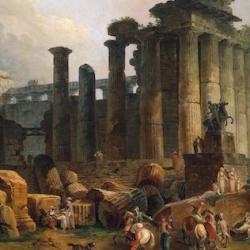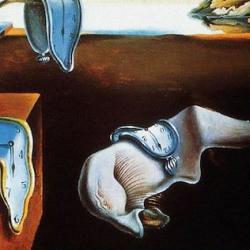In a 2009 University of Michigan dissertation, Richard Persky explores the cultural meaning of time in ancient Greece, focusing on the concept of kairos. According to Persky, “a kairos is a moment of opportunity, the right time to do some particular thing. The allegorical sculpture made by Lysippos and described in an ecphrastic epigram of Posidippos had attributes suggesting speed, sharpness, and elusiveness; its hair was long in front but shaved in back, because the kairos can be seized as it approaches but is lost once it is gone. Behind the idea of kairos is an understanding of the universe as only predictable up to a certain point and full of uncontrollable factors that can affect the likelihood that human action will succeed or fail. By extension, seeing time in terms of kairos makes human action a defining factor and encourages a multiplex view of time, as different circumstances favor or require different kinds of action. Time is thus a qualitative rather than a quantitative phenomenon” (6-7).
Farming illustrates the point: “Agricultural time combined broad predictability with specific unpredictability. The pattern of the seasons can be counted on to repeat itself consistently, but while spring reliably follows winter, the conditions for particular agricultural labors do not repeat themselves at precisely the same time each year. Planting requires that the fields be neither too dry nor too wet, which means that late or early rains lead to anxiety and difficult decisions. Different crops have different growing seasons and require different preparations for planting and tending before the harvest. As a result of the unpredictability of weather and the diversity of crops and agricultural labors, peasant life can be viewed as an ongoing string of kairoi.” Reading the signs was not an esoteric practice reserved for priests and astronomers, but a matter of life and death: “Ancient farmers needed to watch for signs and be ready to carry out or make new plans based on what they saw, often at the risk of hunger or outright starvation” (14-15).
Hesiod’s Works and Days was a manual for reading these signs. It was incomplete; Hesiod gives advice concerning a handful of crops and ignores others, and doesn’t take account of the multiple microclimates that make up Greece. Persky isn’t interested in the details anyway, but in the way that Hesiod expresses “a mentality that stressed the interpretation of signs as a means of identifying kairoi for the tasks that needed to be done to maintain a rural household” (15). According to Hesiod, the behavior of plants, animals, and birds provide clues to climactic changes. Moderns understand the connections: “Migratory birds, including swallows, respond to changes in the length of the day, and thus tend to leave and return to an area at the same points in the solar year, year after year. The growth of plants is likewise closely connected to the length of daylight, although affected by other factors, such as rainfall. In this sense, plant and animal signs do correlate to specific points in the solar or seasonal year. Since the seasons are essentially arbitrary divisions of the year, the return of the swallows (which takes more than a single day) is as reasonable a way as any of defining the beginning of spring (18-19).
Hesiod, though, expresses a less “scientific” mentality in which “observation of animals and plants for purposes of deciding when to sail or when to begin springtime work is very much of a piece with watching animal behavior for omens.” He believed that birds were able “to convey information not otherwise accessible to human knowledge. Such signs always needed, however, to be interpreted” and he provides hermeneutical guidelines for interpretation. At one point, Hesiod writes “The eleventh and the twelfth [of any month] are both good for shearing sheep and harvesting kindly grain, but the twelfth is much better than the eleventh. That is the day when the web of the high-swinging spider is spun in the fullness of the day, while the provident one [i.e., the ant] gathers its pile. On that day a woman should put up her loom and set up her work.” Persky points to the tangle of signifiers that Hesiod is attempting to unravel: “In the sense that a month is the period from new moon to new moon, it is astronomical, specifying a lunar phase in between first quarter and full moon. The information that spiders spin webs and ants gather food around noon on this day of each month casts this as an animal-sign. Ants gathering food is a sign of a propitious time for harvesting grain, and spiders weaving their webs likewise indicate that the present moment is suited for humans to weave cloth – but spiders and ants do these things on other days of the month as well. Hesiod’s instruction is not to watch ants and harvest grain when they gather their own food, or to watch spiders and shear sheep when the spiders weave their webs, but to harvest and shear on specific days of the month. This suggests that the animals themselves recognized the numerological significance of each day. Both animal signs and the count of days, then, can show which dates are favorable and unfavorable for which things, but the count of days takes precedence.” Hesiod’s advice also indicates that “monthly signs like this one will have had to be weighed against annual and other kinds of signs. No matter how propitious the 12th may be for the harvest, it seems unlikely that many farmers would have cut unripe grain or let ripe grain stand for weeks for the sake of following this advice of Hesiod’s” (20).
This raises a problem that Hesiod never addresses directly: Prioritizing signs. What does the farmer do when the astronomical signs contradict the bird omens and both contradict the behavior of significant animals? Hesiod doesn’t say, implying that “there are many channels of communication between humans and gods, by which humans can identify the proper kairoi for particular actions.” Generally, though, Greece developed “an extensive tradition developed that separated out astronomical signs from others and sought to increase their predictive value” (22). The practicalities of farming are thus linked with observation of the natural world, with astronomy, religion, and cosmology.
(Photo R. Scott Hinks.)















